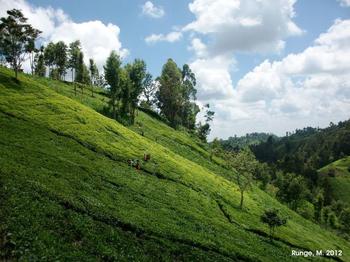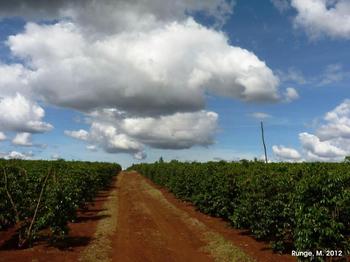Geographical introduction
The geological setting of the Thiririka River catchment is strongly influenced by the development of the East African Rift. The Thirika River has its source in the eastern parts of the Aberdare Range. The Range was developed by tertiary and quaternary volcanism on the eastern edge of the Great Rift Valley, the Kenyan part of the Gregory Rift.
On the contrary to the western flank of the Aberdare Range, the eastern flanks are gently sloping. The narrow valley of the Thiririka River is running in East-south-eastern direction. It is deeply increased and the slopes are steep. In the West, the altitude reaches around 2700m, the outlet of the catchment is located at an altitude of around 1400m.
Typical tropic red soils (Latosols) are located in the mountain areas at high altitudes. They have a high clay content, a thin, but fertile, humus layer and a distinct aggregate structure. These characteristics make them resistant to soil erosion.
The soils of the gentle to sloping slops of the middle and low altitudes are covered by light red soils. There also a lot of patches of grey soils (Gleysols, "vlei soils").
Shallow, stony soils are located on the steep slopes around the channels. The flat areas around the channels are swampy.
Soil erosion and mass movement are one of the major problems in the catchment.
Land use in the Thiririka catchment can be classified in five distinct groups. The classes follow a orographic gradient from the forests and grazing lands in high altitudes to the settled areas in lower altitudes.
The areas in the headwater areas of the Thiririka river are mainly covered with a more or less dense forest. While some of the areas are used for grazing, there is also some natural forest and agroforestry.
In middle altitudes of the catchment are used as tea plantations. They are vertically followed by a mixture of coffee plantations and mixed subsistence farming.
Around the outlet of the catchment, waste land and settlements are the dominating land cover.
The climate—both rainfall and temperature—of the Thiririka catchment is closly related to altitude. Rainfall is less than 700 mm/a in lower altitudes, while its annual averages totals more than 1600 mm at higher altitudes. A bimodal rainfall regime prevailes: There is a long wet season from mid March to end of April and a short wet season in November and December.
According to the system of Koeppen and Geiger, the climate in the catchment is classified as a typical subtropical highland climate (Cfb).

